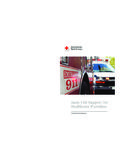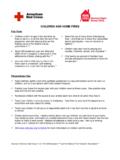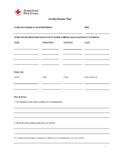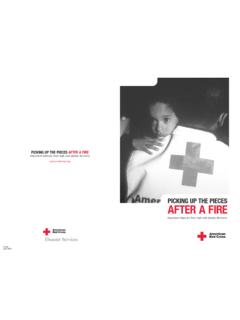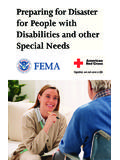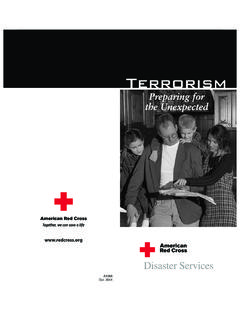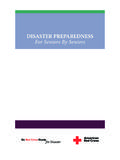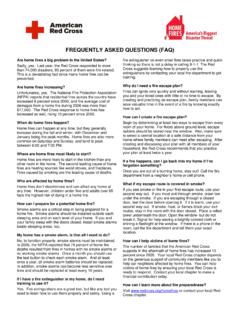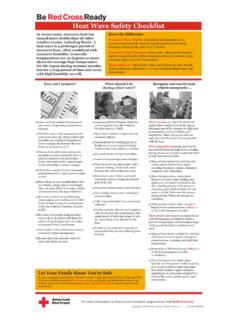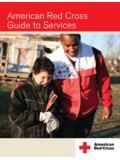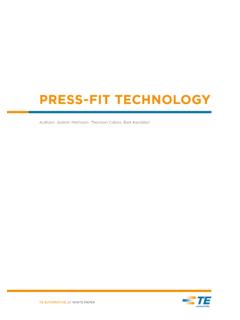Transcription of Guidelines Highlights 2020 - American Red Cross
1 American Red Cross Guidelines Highlights 2020 Resuscitation SuiteBLS, ALS, PALSYou Now Have a Choice in Resuscitation EducationHealthcare providers now have a scientifically equivalent and educationally superior choice from the first provider of resuscitation and first aid training in the United States. Flexible Learning That s Scientifically Equivalent and Educationally Superior American Red Cross Resuscitation SuiteTM courses deliver the science that will save lives while streamlining the education experience. Our BLS, ALS, and PALS courses will provide the solutions you need while saving you time and money. Adaptive learning lets participants test out of sections in Blended Learning by demonstrating competency. Shorter overall course times resulting from more efficient course designs and personalized learning. Real healthcare providers demonstrate content in real hospital settings with no gamification.
2 Clinical scenarios specific to those that might be encountered by EMS providers in field settings. Focus is on critical thinking, decision-making, and team concepts. Online/streaming videos available at no additional cost. Digital student certificate immediately available. Feedback devices recommended but not mandatory. ADA compliant for Blended Learning students. Access Blended Learning on any device computer, tablet, or Cross courses offer a curriculum based on the same ILCOR science and ECC Guidelines as other resuscitation courses. A Full Portfolio to Meet All Needs Certification courses: BLS, ALS, PALS in Instructor-Led and Blended Learning formats. Streamlined certification course renewal options for experienced BLS, ALS, PALS providers: Review Option (brief skills review before testing) and Challenge Option (test-only).All proceeds from Red Cross training support our lifesaving mission, including disaster relief, blood collection, and Service to the Armed Forces.
3 A better solution at a better price. Go to to learn 7/20 IThe American Red Cross Guidelines Highlights 2020 is overseen by the American Red Cross Scientific Advisory Council and is part of the American Red Cross training services programs. The emergency care procedures outlined in these updates and Guidelines reflect the standard of knowledge and accepted emergency practices in the United States at the time these updates and Guidelines were published. It is the reader s responsibility to stay informed of changes in emergency care procedures. PLEASE READ THE FOLLOWING TERMS AND CONDITIONS (the Terms and Conditions ) BEFORE AGREEING TO ACCESS, USE OR DOWNLOAD THE FOLLOWING American NATIONAL RED Cross MATERIALS. BY PURCHASING, DOWNLOADING, OR OTHERWISE USING OR ACCESSING THE MATERIALS, YOU ACKNOWLEDGE AND HEREBY AGREE TO BE LEGALLY BOUND BY BOTH THESE TERMS AND CONDITIONS AND THE American NATIONAL RED Cross TERMS OF USE (AVAILABLE AT ).
4 YOU AGREE THAT THE INCLUDED MATERIALS ARE PROVIDED AS IS AND WITHOUT WARRANTIES OF ANY KIND, AND THAT ANY ACCESS TO OR USE OF THESE MATERIALS IS AT YOUR OWN RISK. The following materials (including downloadable electronic materials, as applicable) including all content, graphics, images and logos, are copyrighted by, and the exclusive property of, The American National Red Cross ( Red Cross ). Unless otherwise indicated in writing by the Red Cross , the Red Cross grants you ( Recipient ) the limited right to download, print, photocopy and use the electronic materials, subject to the following restrictions: The Recipient is prohibited from creating new electronic versions of the materials. The Recipient is prohibited from revising, altering, adapting or modifying the materials, which includes removing, altering or covering any copyright notices, Red Cross marks, logos or other proprietary notices placed or embedded in the materials.
5 The Recipient is prohibited from creating any derivative works incorporating, in part or in whole, the content of the materials. The Recipient is prohibited from downloading the materials, or any part of the materials, and putting them on Recipient s own website or any other third-party website without advance written permission of the Red Cross . The Recipient is prohibited from removing these Terms and Conditions in otherwise-permitted copies, and is likewise prohibited from making any additional representations or warranties relating to the materials. Any rights not expressly granted herein are reserved by the Red Cross . The Red Cross does not permit its materials to be reproduced or published without advance written permission from the Red Cross . To request permission to reproduce or publish Red Cross materials, please submit your written request to The American National Red Cross by going to the Contact Us page on and filling out the General Inquiry 2021 by The American National Red Cross .
6 ALL RIGHTS RESERVED. The Red Cross emblem, and the American Red Cross name and logos are trademarks of The American National Red Cross and protected by various national statutes. IIScience and Technical Content The scientific content and evidence within the American Red Cross Guidelines Highlights 2020 is consistent with the most current science and treatment recommendations from: The International Liaison Committee on Resuscitation (ILCOR) The International Federation of Red Cross and Red Crescent Societies The Policy Statements, Evidence Reviews and Guidelines of: American Academy of Pediatrics (AAP) American College of Emergency Physicians (ACEP) American College of Obstetrics and Gynecology (ACOG) American College of Surgeons (ACS) Committee on Tactical Combat Casualty Care (CoTCCC) Obstetric Life Support (OBLSTM) Society of Critical Care Medicine (SCCM) and the American College of Critical Care Medicine (ACCM) Surviving Sepsis Campaign (SSC)Dedication The American Red Cross Guidelines Highlights 2020 are dedicated to the nurses, physicians, prehospital professionals, therapists, technicians, law enforcement, fire/rescue, advanced practice professionals, lifeguards, first responders, lay responders and all other professionals and individuals who are prepared and willing to take action when an emergency strikes or when a person is in need of care.
7 These updates and Guidelines are also dedicated to the employees and volunteers of the American Red Cross who contribute their time and talent to supporting and teaching lifesaving skills Many individuals shared in the development of the American Red Cross Guidelines Highlights 2020 in various scientific, technical, editorial, creative and supportive ways. Their commitment to excellence made these updates and Guidelines possible. IIIC ontent Direction The development of these updates and Guidelines would not have been possible without the leadership, valuable insights and dedication of the subject matter experts, who generously shared their time to ensure the highest quality Red Cross Scientific Advisory Council Since 1909, the American Red Cross has provided best-in-class resuscitation, first aid and safety education and certification, enabling students to obtain the competency required for effective recognition and care and leading to better outcomes for all those every course stands a team of experts ensuring that what is taught is based on the latest clinical and educational science.
8 This team, known as the American Red Cross Scientific Advisory Council, is a panel of 60+ nationally and internationally recognized experts from a variety of medical, nursing, EMS, scientific, educational and academic members from a broad range of professional specialties, the Council has an important advantage: a broad, multidisciplinary expertise in evaluating existing and new assessment methodologies and technologies, therapies, and procedures, and the educational methods to teach them. Additionally, with on-the-ground experience, its members bring the know-how for real-world experience. The Council provides authoritative guidance on resuscitation, first aid, CPR, nursing, prehospital medicine, emergency and critical care, rescue practices, emergency preparedness, aquatics, disaster health and encourage you to visit our Scientific Advisory Resource Center at would like to extend our gratitude to the members of the American Red Cross Scientific Advisory Council for their guidance and ongoing Development Special thanks to the program development team for their expertise to bring this program through to completion: Dominick Tolli, Danielle DiPalma, Laurie Willshire, Maureen Pancza, Sarah Kyle, Laura Scott, Melanie Sosnin, Ryan Wallace and Iperdesign.
9 David Markenson, MD, MBA, FCCM, FAAP, FACEP, FACHES cientific Advisory Council Co-Chair Chief Medical Officer, American Red CrossE. M. Nici Singletary, MD, FACEP Scientific Advisory Council Co-Chair Professor, Department of Emergency MedicineUniversity of VirginiaNathan P. Charlton, MDScientific Advisory Council, First Aid Subcouncil ChairAssociate Professor, Department of Emergency MedicineUniversity of VirginiaCharlottesville, VirginiaEdward J. McManus, MD Care, Associates, Hillsborough, New JerseyJeffrey L. Pellegrino, PhD, MPH, EMT-B/FF, EMS-I Education Subcouncil Chair Assistant Professor of Emergency Management and Homeland Security University of Akron Akron, OhioJoseph W. Rossano, MDScientific Advisory Council, Resuscitation Subcouncil ChairChief, Division of Cardiology Co-Executive Director of the Cardiac Center Jennifer Terker Endowed Chair in Pediatric Cardiology Associate Professor of Pediatrics at the Children s Hospital of Philadelphia and the Perelman School of Medicine at the University of Pennsylvania Philadelphia, Pennsylvania Peter G.
10 Wernicki, MD, FAAOS Aquatics Subcouncil Chair Orthopedic Surgeon, Pro Sports Vero Beach, Florida Assistant Clinical Professor of Orthopedic Surgery Florida State University College of MedicineIVTable of Contents introduction vi First Aid 1 Suspected Stroke: Supplementary Oxygen Use 1 Opioid-Associated Emergency: Naloxone Dosing Frequency 1 Presyncope: First Aid 2 Direct Pressure, Pressure Dressings, Pressure Points 2 Tourniquets 3 Pediatric Tourniquets 4 Basic Life Support 5 CPR Prior to Call for Help 5 Starting CPR (A-B-C versus C-A-B) 5 Hand Position During Compressions 6 Ventilations for Patients with Respiratory Insufficiency or an Advanced Airway 6 Foreign Body Airway Obstruction Care 7 Opioid-Associated Emergency Resuscitation 8 Advanced Life Support 9 Analysis of Rhythm During Chest Compressions 9 Vasopressors During Cardiac Arrest 9 Intravenous Versus Intraosseous Administration of Drugs During Cardiac Arrest 10 Prognostication with Point-of-Care Echocardiography During CPR 10 Oxygen and Carbon Dioxide Target Levels After Return of Spontaneous Circulation 11 Post-Cardiac Arrest Seizure Prophylaxis and Treatment 11 Prognostication 12 Management of Cardiac Arrest in Pregnancy 12 VPediatric Advanced Life Support 14 Intraosseous Access 14 Pediatric Advanced Airway Techniques 14 Oxygen and Carbon Dioxide Target Levels 15 EEG Monitoring and Seizure Management 15 General Approaches to Fluid
